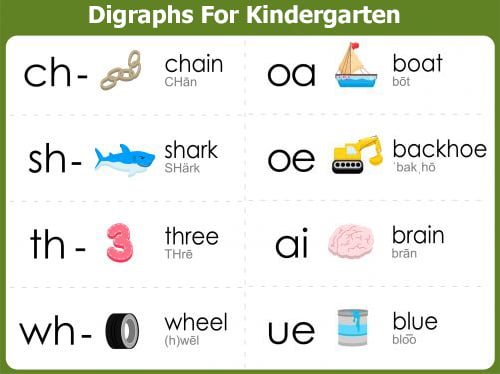When two letters are combined, they produce a single audible sound. When I talk about digraphs, we refer to a pair of letters that prefer to work together as “best buds.”
In this blog article, we’ll go over digraphs in greater detail, provide some examples, and explain how we teach them to our kindergarten, first, and second-graders!
Digraphs are composed of sounds. We’d like to come up with fresh approaches to teaching digraphs for kindergarten. You may learn about digraphs and phonics lessons for kindergarten, first grade, and second grade by reading this post.
What Is A Digraph?

When you write a letter of the alphabet, it produces a sound that only that letter can produce (phoneme). There are vowel and consonant digraphs.
Each letter in this digraph words has a unique sound. (A consonant sound is produced by closing the vocal tract.)
A vowel digraph is formed when two letters are combined to form a vowel sound. One should not compress their lungs when making a vowel sound.
In the United States, they are referred to as consonant digraphs, and this is how many teachers refer to them. That is the subject of this work.
Example
Let’s explain this easier in an example. From these three words, which do you think is the word consisting digraph words?
shore clasp thick
In the above example, “sh” creates one phoneme (sound) in the word shop. The letters “s” and “h” have two distinct sounds. However, it will produce different sounds/sh/ when used together.
The next word that contains a digraph is thick. It has a digraph “th.” as we know, t and h have different sounds. But again, when they are used together, they can create a new unique sound called /th/.
But what about the word clasp? Clasp is made up of 5 sounds: /k/ /l/ /ă/ /s/ /p/. there is no new sound here. Therefore, there is no digraph in the word clasp.
Where can you find the materials for digraphs teaching?
There are several concepts and strategies for teaching digraphs in the early years of school.
When you’re attempting to assist your child to learn at home, you may come across words and phrases you’ve never heard before as a parent.
However, you won’t need to worry since you can find these materials for free online.
Some examples of teaching materials you can find
To introduce sound, you could consider taking one or all of the basics below:
- There are books with decodable consonant digraphs that may be used to teach the sounds.
- Students will be able to see and hear the noises created by graphic cards in order to better understand them (chew, chop, chin, etc.).
- You may form words by combining two letter cards. The student’s responsibility is to utilize a pocket chart to record the same terms you used in class.
To practice the sound, there are certain practices that teachers and students can do together:
Word Sorts
Many words begin with the same letters in squares, so group them all together. Cut and paste words like ch-chap (chart), chink (chink), chop (chip), sh-ship (store), and sheep (a sheep) next to the consonant digraphs (sharp).
Word Building
Children should be taught how to combine two digraphs to form words like ship, sheep, and shop. Things like cut and store should have a variety of potential ends. Other ends (such as cut and store) should have just one type (chin, sharp, etc.)
Word Games
Play bingo with several words from the same word family to help youngsters notice the digraph. You may “shop and chop,” “chip and ship,” and do various other activities.
How to teach digraphs to preschool children?
Young children may be able to acquire digraphs for kindergarten after learning phonics and maybe “blends.” Many individuals struggle with English. Young individuals can learn to spell and utilize English if they have the proper schooling. Remember that the logic is flawed. As a result, digraphs, among other things, must be learned.
What are the greatest methods for remembering things? We can communicate with one another! Preschoolers will be able to perform a variety of exciting things using digraphs, such as playing games with them, as a result of this.
Check out the following articles to learn more about training children to read at an early age:
It may be difficult for children to spell terms they are unfamiliar with. Rebecca Treiman and Brett Kessler wrote the book “How Children Learn to Write Words“. They discuss how to write in the past tense. Mess is one example (messed). The other is known as (called). In the past, both had two syllables. In the past, there existed an odd trend.
It is critical that kids learn to read and write. They must also be taught how to read and write phonics and sight words.
We can notice that some children perform better in some academic courses than others because their brains are different. We believe that preschoolers can learn digraphs, and we say so. After they’ve learned how to read and write, they’ll study the fundamentals of reading and writing.
Don’t worry if everyone in the class doesn’t like it. Continue singing the songs, using the flashcards, and pointing out the instructive letters and words, and you’ll grow better.
When children study digraphs in kindergarten and first grade, they will benefit from early practice.
Making expressions that are associated with digraphs
To learn digraphs, play games and move your hands.
Preschoolers and early learners may be able to recall digraphs if you play a fun imitation game with them. Children can learn how to write digraph phrases by imitating you.
The digraph “Sh” and the sound “Shhhh” are most commonly used. “Shhhh” is often spoken with one’s finger on one’s lips. Many times, children hear “Shhhh” and figure out what it means. They may not know how to spell it or pronounce it. Shouldn’t it be “suh” and “hu”? There is no way!
When you show a flashcard with the letters S and H together and say, “S and H make Shhhhh,” children may learn that letters may be combined to create new sounds. Then repeat the “silent” motion (i.e. index finger on lips). Students can utilize this strategy to help them recall the digraph when doing future reading practice.
Adding the visual aids to your lesson
You may educate your children digraphs using image flashcards.
They are also helpful for teaching digraphs. You may use the term “flashcards” in the same way that you can use “posters” or “charts.” The idea is to create anything that can be spelt with digraphs.
The digraph should be quite evident if you write it on your flashcards. If it shows the entire word, make the digraph component larger or divide it.
You may demonstrate this by using a flashcard with a chair and the letters “Ch.” What is the sound of the letter “Ch”? What are some words that begin with the letter “Ch”? A chair will prompt them to consider a response.
Digraphs can be used in words and flashcards throughout the class, not simply at the beginning and conclusion, as some people believe.
You may utilize sound-only flashcards in addition to show-and-sound flashcards. “Choo-Choo” is written on the side of a train, and a turtle that moves at a “slow” pace.
Begin by utilizing language that youngsters are already familiar with. The first thing you should perform with the flashcards is digraphs of vowels and consonants. You don’t want to begin your first day of preschool with a slew of digraphs!
Play word-building and match-up games
Playing word games with young children might help them learn digraphs.
In the snow, children were practicing digraphs. Making words out of two or three letters is one method of drilling a topic. We’d want to know what we’re attempting to express. Many individuals obtain these games from printed sources, such as books (such as worksheets, reusable laminated charts, or cards). You may make your own if you like.
The word must be accompanied by the right digraph, or it will not work. As a result, they’ll have to grow used to it. To locate the proper digraph, use the “match up” worksheet.
Items with names that begin with the digraph should also be examined in the graph.
Words may be formed by assembling card pieces (i.e. word-building cards). These flashcards should have distinct blends and digraphs that finish or begin with them. It may be used with “ick,” “air,” “lun,” and bea when coupled with “ch.” A chair, chip, lunch, and the beach are all slang terms for chicken. It is also possible to utilize a “sh” card. Children should try to construct the word “ship” by combining “sh” and “ip.”
Is it necessary to include non-digraph word blends in these games as well? According to this source, digraphs should be introduced before blends for kindergarten. Nonetheless, the decision is yours and your children’s. If children already know some mixes, they should begin with them.
Books reading
It is recommended that you study digraph-related literature.
Certain books, notably digraphs, are specifically designed to accentuate letter sounds. They may even color-code the digraphs and sounds in the text to make them simpler to distinguish for a child.
These books will help you understand digraphs in “actual” phrases. They also aid in the acquisition of new digraph words.
Sing along the digraph songs
We’re sending this concept forward just because we believe you’ll be able to get a lot of support on YouTube. You may assist the children in realizing that digraphs are single-sound phonetics formed up of two words in this manner. You may help them by singing songs with them during circle time.
Make the digraphs as the main theme of the activities of the day
Pay attention to digraphs throughout the day.
You may devote a week or a month to the letter “A” and its words. This is comparable to making digraphs your primary focus for a week or a month.
This month has a “ch” week. “Cherries, cheese, and chips!” may be on the menu for snacks.
Look for terms like “chicken,” “chain,” and “cheek.” This one may necessitate the use of photographs or the reading of books.
When they have time to do crafts, young people can build paper chains or “children’s garlands.” Outside of the classroom, “chalk” can also be used. Why? Because they all begin with the letter “ch”!
You should “follow” the teacher whenever they are outside.
Maintain a large “Ch” on your classroom wall so that students may see it when they look at their work.
Learning about digraphs using digraphs, phonics, and letters may be enjoyable. Children under the age of seven are prone to becoming bored with repeating what they’ve already learned. The usage of flashcards is beneficial, but it should not be overused. Preschoolers can learn the digraphs while having fun if they are made into exciting activities and games that they can do and play.
Digraph activities
Learning digraphs for kindergarten can be made simpler by practicing them frequently and in various ways. For example, for each digraph, we prefer to choose a few target words and then provide children with a variety of methods to read, write, and talk with those words in sentences.
Here are some examples of the digraph activities:
Clip Card Wheels
The first thing a pupil should learn is how to determine the digraph of a word. After pronouncing the word loudly, students must figure out the initial digraph.
Ask your children to speak the digraph “sh” by repeating the word “ship,” and then ask them to repeat it back to you.
It was one of the first activities I performed with my children. Clip card spinners were created by us. Students will cross off any photos that begin with a digraph sound and keep the others. This can aid pupils in the future when they have to differentiate the sound of a digraph while rereading the text.
Anchor Chart Circle Map
Make them come up with words for each digraph. The digraph should be put in the center of the anchor chart, on top of the other components. It will take them a few minutes to think of words that begin in the same way as that digraph. Ask pupils to add words to the anchor chart and write them down (or spell them out) in the space provided. Instead, try drawing an image for each one.
Every time I introduce a new digraph to my kids, I have them create a chart to help them remember it. They won’t forget it this way. I’d want to put them on display in my classroom for the next two weeks to assist pupils in learning digraphs, so I can show them off.
On paper, you can accomplish the same thing that you can do together.
Cut and Paste Sort
Cutting and pasting the words together is another approach to practice detecting digraphs. Students look at an image and speak the word in this manner. Sorting photos is an effective approach to locate digraphs. For example, the letters “sh” and “ch” are both digraphs.
Stamp It
Identify and read digraphs properly to learn how to spell them correctly, and then learn how to spell them correctly. Kindergarteners should be able to spell just the digraph, not the entire word, as long as it isn’t a short vowel word. They can’t write it because they can’t spell it phonetically. This year’s first-graders will learn more digraphs than they did last year.
This assists young children in learning to write digraphs for kindergarten. Following that, the students will look at the picture and use stamps to fill in the digraphs that they identify.



0 Comments